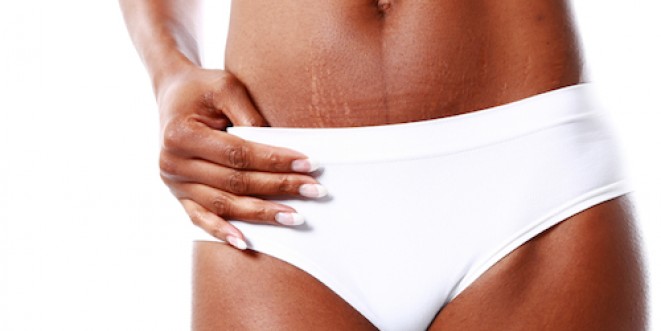Q: How Can I Reduce Or Eliminate Stretch Marks?
By Faith A. Coleman, MDPublished: April 23, 2014

Stretch marks are known medically as striae distensae. They can affect anyone who has seen a growth spurt during the teenage years, in pregnancy, with a rapid weight gain or loss, and in weight lifters. When they occur with pregnancy, they are also called striae gravidarum.
The skin is composed of several layers. Stretch marks appear like thin, red, parallel lines in the dermis, the middle or second layer of skin; a result of tearing the dermal fibers. There is also loss of elastic fiber and collagen from the dermal layer. They occur when the skin is stretched quickly, as with rapid weight gain. The stretched skin becomes thin and silvery. The marks can resemble scars.
The exact cause of stretch marks is unknown. They are thought to have a genetic component – individuals with a strong family tendency to form stretch marks are more likely to form stretch marks, as well as more-visible stretch marks. They most often appear when there are increased levels of hormones creating changes throughout the body.
It is thought that as many as 90 percent of women will form stretch marks at some time in their lives. Men, however, are no strangers to stretch marks. They often occur in males, especially during an adolescent and teen period of rapid growth in height and weight. Rapid increases in muscle mass, such as those seen with weight-lifting and body-building are frequently associated with the formation of striae in males.
Prenatal distension of the abdominal wall itself isn’t entirely the reason that stretch marks occur during pregnancy. The hormonal changes that occur with pregnancy have a significant role in the formation of striae gravidarum. As the hormones shift and change during pregnancy, they interact with the skin – the result is stretch marks.
It is common for pregnant women to have the striae form on the breasts, buttocks and thighs, as well as the abdomen. Because stretch marks are primarily caused by hormonal changes in the body, which can’t be controlled, it’s difficult, if not impossible, to prevent them from happening.

The best time to treat stretch marks is early and often, before they have time to fade into a more permanent state, according to Dr. Eric Berstein, Clinical Associate Professor at the University of Pennsylvania. Stretch marks usually start out as red lines, but may start out pink, reddish-brown, brown, or dark brown, depending on skin tone when they appear. Over time the marks will slowly fade to a silvery color, and be less noticable.
CAUTION: Consult your physician before starting any treatments, especially during pregnancy. Potential risks and benefits of any treatment in any individual should be assessed before starting any treatment.
No topical treatments, available over-the-counter, have been proved effective to prevent the formation, minimize or eliminate the appearance, of stretch marks completely.
Treatment methods include:
Corticosteroid creams: These may help to minimize the appearance and formation of stretch marks. Stretch marks start with inflammation in the skin, and corticosteroid creams help reduce inflammation.
Alpha-hydroxy acid-containing creams: These help in remodeling the skin’s collagen, improving the overall appearance.
Retinoid creams: These improve the overall appearance of the skin by remodeling the skin’s collagen.
Vascular laser: A vascular laser is the most effective treatment method for red and purple stretch marks. They promote the growth of healthy new collagen. Laser treatment may also reduce the inflammation, preventing further damage to the skin and halting the formation of new stretch marks. The laser targets swollen and inflamed blood vessels. Treatments usually require 3-6 sessions.
Fractionated laser: This type of laser may be the best choice for older, silvery or white stretch marks. It triggers the growth of new collagen and healthy tissue, by targeting the skin surrounding the stretch marks, making the skin smoother and the stretch marks less noticable. At least three sessions are necessary, at a cost of up to $1000 per session.
Intense pulsed light laser (IPL): This type of laser improves the appearance of pink or red stretch marks by reducing the color changes. It does not improve textural variations in the skin.
Microdermabrasion/chemical peels: These treatments remove the top layer of dead skin cells. They can improve the texture and tone of your skin after multiple treatments. They don’t, however, get deep enough to reach the dermal layer where the stretch marks have formed.
Surgery: With a tummy tuck or breast reduction, stretch marks may be removed along with the tissue. These surgeries are costly and carry the risks of major surgery and anesthesia. They should not be performed just for removal of stretch marks.
There are countless creams available over the counter that promise to eliminate or minimize stretch marks. There is little evidence that they are effective. A 2008 study published in the British Journal of Obstetrics and Gynecology found that cocoa butter is no more effective than placebo. Other studies with other creams show similar results.
This content is not intended to be a substitute for professional medical advice, diagnosis, or treatment. Always seek the advice of your physician or other qualified health providers with any questions you may have regarding a medical condition. Never disregard professional medical advice or delay in seeking it because of something you have read on this Website.
Like what you're reading? Sign up for our free newsletter and never miss a post! Plus get a FREE digital version of our Issue No.10 with sign up.
- Understanding Vitiligo - January 14, 2015
- 10 Tips for Softer, Smoother Skin - July 2, 2014
- 10 Reasons You Can’t Sleep and What To Do About Them - June 17, 2014
- Q: How Can I Reduce Or Eliminate Stretch Marks? - April 23, 2014
- Q: Is My Husband’s Premature Ejaculation Treatable? - May 28, 2014
- 5 Most Important Pre-conception Health Checks - October 28, 2014
- No Period For 3 Months And I’m Not Pregnant. Is It Normal? - April 2, 2014
- Understanding Psoriasis - April 27, 2015
- Breast Cancer in Nigerian Women: TALK IT UP! - April 27, 2015
- Q: What Causes Heartburn And How Can I Ease It? - June 25, 2014











